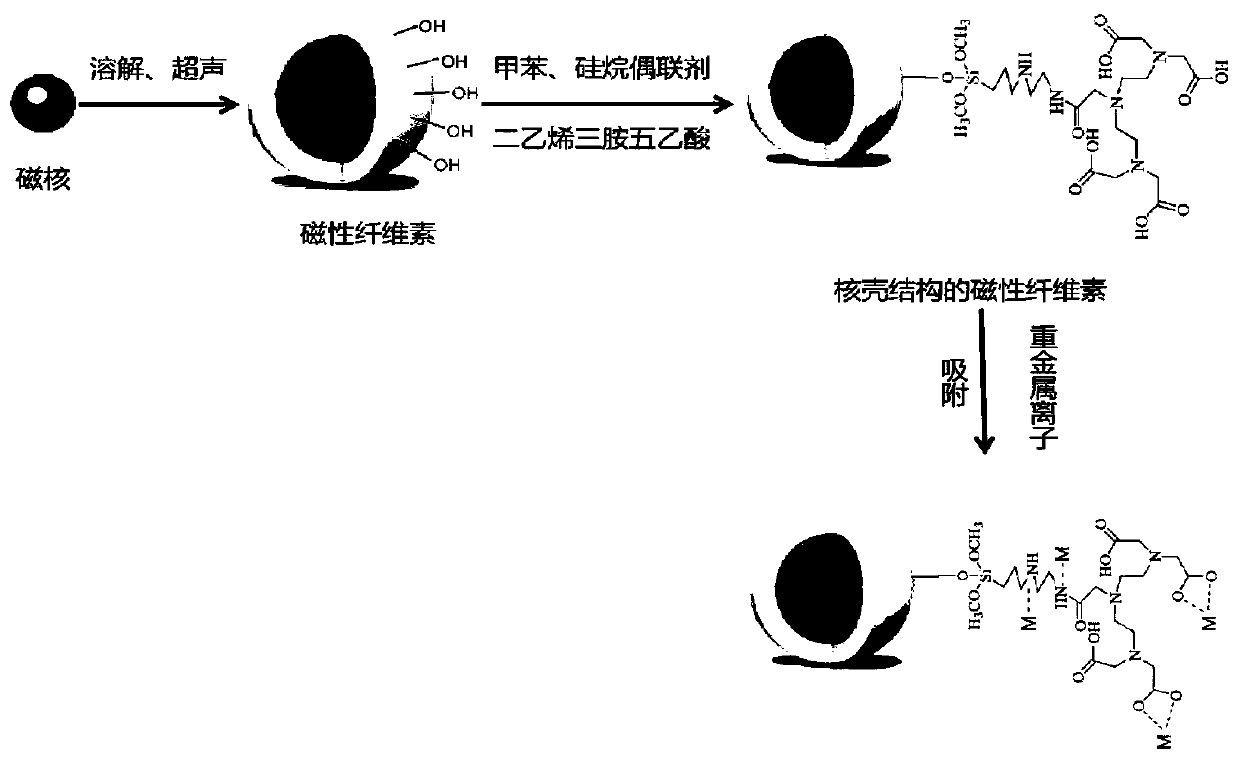Preparation method and application of magnetic cellulose microspheres with core-shell structure
A technology of cellulose microspheres and core-shell structure, applied in chemical instruments and methods, alkali metal oxides/hydroxides, inorganic chemistry, etc. Large and other problems, to achieve excellent chelation, low non-specific adsorption, reduce the effect of loss
- Summary
- Abstract
- Description
- Claims
- Application Information
AI Technical Summary
Problems solved by technology
Method used
Image
Examples
Embodiment 1
[0033] (1) Dissolve ferric chloride hexahydrate and ferric dichloride tetrahydrate in deionized water at a molar ratio of 1:1, heat to 70°C, condense and reflux for 3 hours, then add ammonia solution, in which FeCl3 The mass ratio of the three, deionized water and ammonia water is 1:6:1; after cooling to room temperature, the magnetic particles produced are collected with a magnet, and the product is washed 3-5 times with distilled water to obtain Fe 3 o 4 magnetic core;
[0034] (2) After dissolving microcrystalline cellulose in 7% NaOH / 12% urea mixed solution solvent, a cellulose solution with a concentration of 4% was obtained; the above-mentioned magnetic core was mixed with the prepared cellulose solution and ultrasonically mixed for 15 minutes and continuously stirred for 24 hours , wherein the mass ratio of the magnetic inner core to the middle layer cellulose is 1:5, then collect the product with a magnet, wash the product 3-5 times with distilled water and ethanol res...
Embodiment 2
[0038] (1) Dissolve ferric chloride hexahydrate and ferric dichloride tetrahydrate in deionized water at a molar ratio of 1.5:1, heat to 80°C, condense and reflux for 2 hours, and then add ammonia solution; where FeCl 3 The mass ratio of the three, deionized water and ammonia water is 1:4.5:1. After cooling to room temperature, the magnetic particles produced are collected with a magnet, and the product is washed 3-5 times with distilled water to obtain Fe 3 o 4 magnetic core;
[0039] (2) after dissolving the hydroxyethyl cellulose material in lithium chloride / dimethylacetamide (LiCl / DMAc) mixed solution solvent, the obtained concentration is a 4% cellulose solution; take the above-mentioned magnetic inner core and the obtained The cellulose solution was mixed and ultrasonically stirred for 22 minutes and continuously stirred for 16 hours, wherein the mass ratio of the magnetic inner core to the middle layer of cellulose was 1:3, then the product was collected with a magnet,...
Embodiment 3
[0043] (1) Dissolve ferric chloride hexahydrate and ferric dichloride tetrahydrate in deionized water at a molar ratio of 2:1, heat to 90°C, condense and reflux for 1 hour, then add ammonia solution, in which FeCl 3 The mass ratio of the three, deionized water and ammonia water is 1:3:1; after cooling to room temperature, the magnetic particles produced are collected with a magnet, and the product is washed 3-5 times with distilled water to obtain Fe 3 o 4 magnetic core;
[0044] (2) After dissolving hydroxymethylcellulose in the tetrabutylammonium fluoride hydrate / DMSO mixed solution solvent, a cellulose solution with a concentration of 4% was obtained; the above-mentioned magnetic inner core was mixed with the prepared cellulose solution and ultrasonically Stir continuously for 30 minutes for 8 hours, wherein the mass ratio of the magnetic inner core to the middle layer cellulose is 1:1, then collect the product with a magnet, wash the product 3-5 times with distilled water...
PUM
| Property | Measurement | Unit |
|---|---|---|
| adsorption capacity | aaaaa | aaaaa |
Abstract
Description
Claims
Application Information
 Login to View More
Login to View More - R&D
- Intellectual Property
- Life Sciences
- Materials
- Tech Scout
- Unparalleled Data Quality
- Higher Quality Content
- 60% Fewer Hallucinations
Browse by: Latest US Patents, China's latest patents, Technical Efficacy Thesaurus, Application Domain, Technology Topic, Popular Technical Reports.
© 2025 PatSnap. All rights reserved.Legal|Privacy policy|Modern Slavery Act Transparency Statement|Sitemap|About US| Contact US: help@patsnap.com



